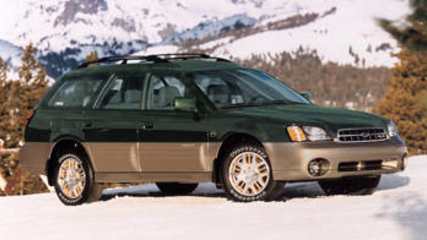Used Subaru Outback review: 1996-2002
By Graham Smith · 29 Jan 2009
Holden has caught on, so has Ford, but both have got a long way to go if they want to catch up with Subaru who hit the market in 1996 with the first family wagon with the ability to go off-road. As Holden rolls out the Commodore-based Adventra all-wheel drive wagon, and Ford makes noises about its all-new Territory which is due in 2004, Subaru’s Outback continues to rack up sales in a market segment that shows no sign of slowing.The idea of blending a regular family wagon with all-wheel drive makes a lot of sense. You get the roominess of a wagon, the dynamic safety of all-wheel drive, and the ability to explore bush tracks in the one package. The great news is that you don’t have the massive size and on-road clumsiness of the bigger four-wheel drive wagons.MODEL WATCHSubaru made no bones about the Outback when it was launched in 1996. It was a Liberty wagon put on a course of steroids, they admitted, but it was conceived to offer buyers the flexibility of a four-wheel drive without the downsides of size, compromised safety and sloppy chassis dynamics. It was perfect for the buyer who wanted an all-round vehicle with reasonable off-road capability without sacrificing the comfort and style that goes hand-in-hand with a passenger cars.It was clear from the outset that the Outback was a jacked-up Liberty wagon. It looked like a Liberty, but with increased ground clearance, although the large front and rear overhangs rather limited its approach and departure angles.Add to that the lack of low range gearing and no real protection for vulnerable components underneath and you get the idea that the Outback wasn’t intended to go deep into the bush. Subaru admitted as much at its launch when it quoted data that said as many as 95 per cent of new off-roaders never leave the black top.To give it the ability to go off-road Subaru raised the suspension by 35 mm and fitted some 70-series tyres to 15-inch rims, which resulted in 200 mm ground clearance and made it comparable to many more serious off-roaders.The suspension was also retuned to handle the tough stuff, with retuned shocks and springs, and increased wheel travel, which made it quite comfortable even when traversing some relatively rough forest tracks.But it was at its best on slippery surfaces when its all-wheel drive and passenger car chassis dynamics combined to give it an assurance and level of safety unheard of in an off-roader.Power came from Subaru’s 2.5-litre horizontally-opposed double overhead cam four cylinder engine. Boasting a modest 115 kW and 221 Nm it was sufficient to give the Outback good performance without ever threatening to leave you with whiplash.More performance was unleashed in 2000 when the H6 was released with the 3.0-litre engine, which delivered 154 kW and 282 Nm, but ran on PULP.Initially there was no choice of gearbox, it came with a four-speed auto and that was it. Still, it shifted smoothly, and there a choice of ‘power’ or ‘regular’ shift modes, and a ‘hold’ button that would lock the trans and control up or down shifts. The choice was expanded to include a five-speed manual with dual-range four-wheel drive in 1997, which added to its off-road prowess if you were serious about going bush.Inside there was plenty of room even for tall occupants with generous front and rear seat leg and head room, plus generous load space in the rear. The 70/30 split-fold rear seat added to the capacity and flexibility of the interior, and there was a retractable blind to cover the contents in the load area.The interior was also well equipped with lots of knickknacks, like delay courtesy lights, cup holders, and a powerful sound system.Two models were launched. The regular model which came with alloy wheels, ABS, remote central locking, cruise, fog lamps, power windows and mirrors, roof racks, and velour trim. On top of that the Limited got standard air-con, dual airbags, leather and wood grain, and CD sound.IN THE SHOPSubarus are generally bulletproof in the mechanical department. Subaru dealer servicing tends to be on the high side, so check service record carefully to see that it has been done, and who has carried it out.Although few Outbacks travel off-road, apart from the odd foray down a gravel road, look for signs of bush bashing anyway. Take a look underneath to signs of impact that might have damaged exposed componentry. Get it up on a hoist if you’re not sure.Tyres can wear out quite quickly, particularly on the hotter H6 model, and 50,000 km is not unusual. Brakes also need doing around 50,000 km.OWNERS SAYOutback owners are generally lavish with their praise of the car. They particularly like the combination of the wagon size and flexibility with the safety of the all-wheel drive system. Many say it’s great for towing, and a number have towed pop-tops and campers around the country on their holidays.One, Darren Wilkie, has been off roading in his and says it performed exceptionally, handling creek crossings, steep heavily rutted tracks, and soft sand with surprising ease.Main gripe is the headlights, which a number of owners say are “poor” to the extent that they have replaced them with more powerful units.LOOK FOR• good build quality• tough, reliable mechanical package• roomy accommodation for family• safety of all-wheel drive• handling on slippery roads• surprising off-road capability


